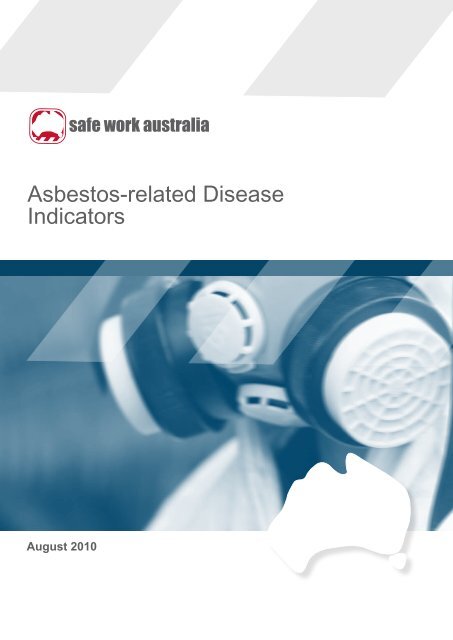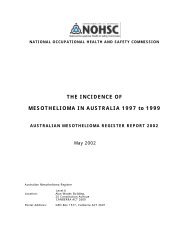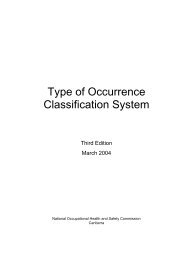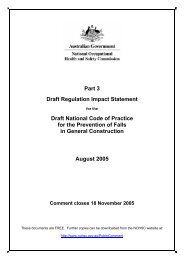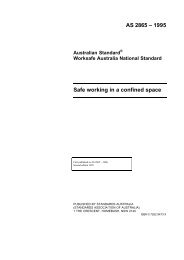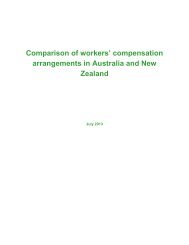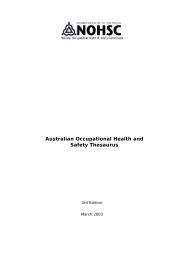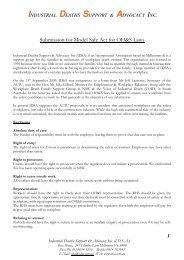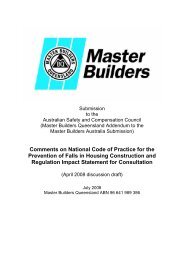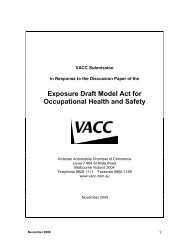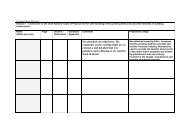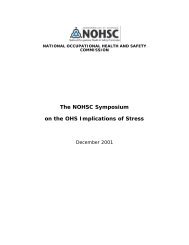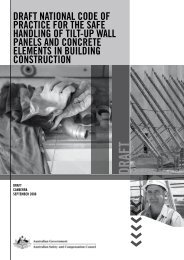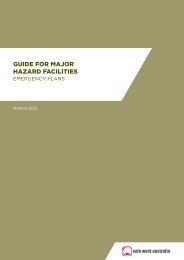Asbestos-related Disease Indicators.indd - Safe Work Australia
Asbestos-related Disease Indicators.indd - Safe Work Australia
Asbestos-related Disease Indicators.indd - Safe Work Australia
Create successful ePaper yourself
Turn your PDF publications into a flip-book with our unique Google optimized e-Paper software.
<strong>Asbestos</strong>-<strong>related</strong> <strong>Disease</strong><strong>Indicators</strong>August 2010
© Commonwealth of <strong>Australia</strong> 2010ISBN 978-0-642-33090-1 [Online PDF]ISBN 978-0-642-33091-8 [Online Word document]This work is copyright. You may download, display, print and reproduce thismaterial for your personal,non-commercial use or use within your organisation,provided that an appropriate acknowledgement is made (retaining this notice), andthe material is not altered or subjected to derogatory treatment. Apart from any useas permitted under the Copyright Act 1968, all other rights are reserved. Requestsand inquiries concerning reproduction and rights should be addressed to:Commonwealth Copyright AdministrationAttorney-General’s Department3 - 5 National CircuitBarton ACT 2600Email: commonwealth.copyright@ag.gov.auWeb: www.ag.gov.auDisclaimerThe information provided in this document can only assist you in the most generalway. This document does not replace any statutory requirements under anyrelevant State and Territory legislation. <strong>Safe</strong> <strong>Work</strong> <strong>Australia</strong> is not liable for anyloss resulting from any action taken or reliance made by you on the information ormaterial contained in this document. Before relying on the material, users shouldcarefully make their own assessment as to its accuracy, currency, completenessand relevance for their purposes, and should obtain any appropriate professionaladvice relevant to their particular circumstances.To the extent that the material on this document includes views orrecommendations of third parties, such views or recommendations do notnecessarily refl ect the views of <strong>Safe</strong> <strong>Work</strong> <strong>Australia</strong> or indicate its commitment to aparticular course of action.
ContentsPage no.Report summary ........................................................................... vIntroduction .................................................................................. vi1. <strong>Asbestos</strong>-<strong>related</strong> diseases ...................................................... 12. Mesothelioma............................................................................ 33. <strong>Asbestos</strong>is ................................................................................ 74. Preventive policy .................................................................... 105. Explanatory notes .................................................................. 126. References .............................................................................. 15<strong>Asbestos</strong>-<strong>related</strong> <strong>Disease</strong> <strong>Indicators</strong>, August 2010 ... iii
Report summaryThis is the fi rst <strong>Safe</strong> <strong>Work</strong> <strong>Australia</strong> report on <strong>Asbestos</strong>-<strong>related</strong> <strong>Disease</strong> <strong>Indicators</strong>.In this report, only mesothelioma and asbestosis have been used to indicate theextent of asbestos-caused disease in <strong>Australia</strong>. <strong>Asbestos</strong>is is caused exclusively byasbestos and asbestos is the only known cause of mesothelioma.This report uses data from the <strong>Australia</strong>n Institute of Heath & Welfare for thenumber of new cases of mesothelioma, the number of deaths attributed tomesothelioma, and the number of asbestosis-<strong>related</strong> hospitalisations; NSW Dust<strong>Disease</strong>s Board and the National Data Set for Compensation-based Statisticsfor the number of accepted workers’ compensation claims for mesotheliomaand asbestosis; and the <strong>Australia</strong>n Bureau of Statistics for cause of death data.Although compensated cases of mesothelioma and asbestosis have beenaccepted as work-<strong>related</strong>, the number of new cases, deaths and hospitalisations<strong>related</strong> to asbestos-caused diseases are not necessarily work-<strong>related</strong>.The main findings in this report follow.Changes in the nature of occupational exposureMesothelioma<strong>Asbestos</strong>isPrevention policy> In the past, exposure to asbestos fibres usually occurred while miningasbestos; manufacturing asbestos containing products; or using thoseproducts, primarily while constructing buildings.> Currently, the main source of exposure to asbestos fi bres are old buildingsundergoing renovation or demolition where building maintenance anddemolition workers are employed.> Over the period 1982 to 2006 the total number of new cases ofmesothelioma increased from 156 in 1982 to 649 in 2003. Since then, thenumber of new cases has decreased to 579 in 2006.> Since 1997 the overall number of deaths resulting from mesotheliomaincreased from 416 to 628 in 2008.> Over the period 1998–99 to 2007–08, there were 1146 hospitalisations<strong>related</strong> to asbestosis of which 97% were for men.> There were 258 accepted asbestosis-<strong>related</strong> compensation claims in 2008;this is a 25% decrease from the 342 compensated claims in 2003.> Since 1998 the number of deaths attributed to asbestosis increased from43 to 109 in 2008.> The development of national model regulations for asbestos aim toharmonise jurisdictional regulations and provide, for the fi rst time, aconsistent framework for the minimisation of exposure; the removal ofasbestos; and the management of remaining asbestos materialsin workplaces.<strong>Asbestos</strong>-<strong>related</strong> <strong>Disease</strong> <strong>Indicators</strong>, August 2010 ... v
Introduction<strong>Asbestos</strong>-<strong>related</strong> diseases are responsible for an increasing number of deaths in<strong>Australia</strong>. In 2008, the most recent year covered by this publication, 628 deathsattributable to mesothelioma were registered, and 109 to asbestosis. The numberof deaths caused by lung cancer and other diseases possibly <strong>related</strong> to asbestosexposure is unknown.These deaths are the direct result of, in most cases, work-<strong>related</strong> exposure toasbestos fi bres up to 40 years ago. <strong>Asbestos</strong> is a mineral rock that is made up ofmasses of tiny fibres and occurs in a number of forms, three of which were usedcommercially in <strong>Australia</strong>. They are amosite, crocidolite and chrysotile.<strong>Asbestos</strong> was mined in <strong>Australia</strong> for over 100 years — ceasing by 1983. Thisdomestic production, combined with asbestos imports, gave rise to <strong>Australia</strong> havingthe world’s highest per-capita use of asbestos in the 1950s (Leigh et al, 2002). Thishigh rate of usage reflected the very useful thermal and mechanical properties ofthe material. These properties led to its extensive use in a multitude of domestic andindustrial products and, in particular, in fibre-cement products like pipes, wall panels,and roof sheeting. The use and importation of all forms of asbestos (with a few veryspecialised exceptions) was prohibited in <strong>Australia</strong> from December 2003.When asbestos is mined or processed, or when asbestos-based products aresanded, sawn or drilled, it can form a fi ne airborne dust made up of tiny fi bres.These fi bres are easily breathed in to the lung where they can become embedded.Due to the small size and elongated shape of the particles they can resist thelung’s natural cleaning process and may cause serious health problems in lateryears. In particular, the fi bres can work their way through the lung tissue and intothe pleura – the membrane that surrounds the lungs.Exposure to asbestos can cause respiratory diseases and cancers including:> lung cancer> mesothelioma, (pleural, peritoneal or pericardial)> asbestosis, and> some other cancers.Besides this report, <strong>Safe</strong> <strong>Work</strong> <strong>Australia</strong> has undertaken a number of initiatives tobetter monitor and improve the understanding of asbestos-<strong>related</strong> diseases.These include:> The publication of the Mesothelioma in <strong>Australia</strong> report: a detailedexamination of diagnosis and deaths data collected by cancer registries andthe <strong>Australia</strong>n Bureau of Statistics.> The establishment of the <strong>Australia</strong>n Mesothelioma Registry to replace the<strong>Australia</strong>n Mesothelioma Register which was suspended in 2008 becauseof the considerable reduction in the number of notifi cations under new stateprivacy laws. In 2010, <strong>Safe</strong> <strong>Work</strong> <strong>Australia</strong> contracted a consortium led bythe Cancer Institute of New South Wales to manage the new <strong>Australia</strong>nMesothelioma Registry which will combine the mandatory notifi cation ofmesothelioma to the cancer registries with timely follow up of consentingpatients to collect exposure information.> The instigation of a survey to examine exposure to asbestos amongconstruction workers and their attitudes, perceptions and behaviours <strong>related</strong>to asbestos (<strong>Asbestos</strong> Exposure and Compliance Study of Construction andMaintenance <strong>Work</strong>ers).<strong>Asbestos</strong>-<strong>related</strong> <strong>Disease</strong> <strong>Indicators</strong>, August 2010 ... vii
1 <strong>Asbestos</strong>-<strong>related</strong> diseasesExposure to asbestos<strong>Asbestos</strong> has been used for thousands of years in pottery, fabrics and otherartefacts. During the Industrial Revolution in the nineteenth century, it was usedextensively for its insulation and fi re retardant qualities (Greillier & Astoul 2008).The association between asbestos and respiratory illness among asbestos workerswas suspected by the medical profession as early as the beginning of the twentiethcentury. By the middle of the twentieth century there was indisputable evidence ofthe health risk asbestos fi bres posed to workers and others (Asthma Foundationof SA, 2010).Changes in the nature of occupational exposureOccupationsTo prevent further exposure to asbestos fi bres and asbestos containing materials,national and jurisdictional governments and regulators have developed andimposed strict regulations on its use and handling (see Prevention Policy on page10 for more information on this topic).The end of mining in <strong>Australia</strong> in the early 1980s, and the national ban on asbestosproduction, importation and use in December 2003, brought about a change inthe way workers were, and still are, exposed to asbestos. In the past, exposure toasbestos fi bres usually occurred while mining asbestos; manufacturing asbestoscontaining products; or using those products, primarily while constructing buildings.Currently, the main source of exposure to asbestos fi bres are old buildingsundergoing renovation or demolition where building maintenance and demolitionworkers are employed. This is an outcome of the heavy reliance on asbestosproducts in buildings during the 1950s, 1960s and 1970s (NOHSC 2005). <strong>Asbestos</strong>containing materials were used as thermal insulation for pipes, ducts in buildings,plant and furnaces, ceilings and wall cavities. <strong>Asbestos</strong> cement sheets and roofingwere also used extensively.The burden of asbestos-<strong>related</strong> disease on occupations associated with asbestosmining in <strong>Australia</strong> should diminish in the longer term because of the cessation ofasbestos mining in 1983. However, the widespread use of asbestos in constructionand manufacturing during the post-war decades may mean there will be more, asyet undiagnosed, cases of asbestos-<strong>related</strong> diseases among workers from thesetwo industries.The <strong>Australia</strong>n Mesothelioma Register, which operated from 1986 to 2007,collected and monitored data on the number of new cases of mesothelioma andpast exposure to asbestos. The Register’s data shows that in the past workers whohad the highest rates of mesothelioma were those who had worked in occupationsassociated with asbestos mining or dust forming operations such as handling,sawing, sanding, grinding, drilling, turning or general maintenance and renovation.Specific occupations recording high numbers of workers exposed included:carpenters & joiners; Wittenoom workers; builders & builders’ labourers; navy &merchant navy workers; railway workers; boiler makers (cleaners, attendants,installers & welders); and power station workers.The National Dataset for Compensation Based Statistics (NDS) contains informationfrom 2000–01 onwards (2007–08 are preliminary data) on workers’ compensationclaims that involve work-<strong>related</strong> disease. The NDS data shows that occupationgroups with higher than average rates of workers’ compensation claims formesothelioma over the three-year period 2005–06 to 2007–08p included; Power1 ... <strong>Safe</strong> <strong>Work</strong> <strong>Australia</strong>
generation plant operators; Carpentry and joinery tradespersons; Communicationstradespersons; Metal fitters and machinists; Electricians; and Plumbers.For asbestosis, the occupation groups with higher than average rates of workers’compensation claims over the same three-year period included Railway labourers;Freight & furniture handlers (includes Stevedores); Bricklayers, Painters &decorators; and Carpentry & joinery tradespersons. Half of all asbestosis claimswere made by workers in the manufacturing industry, of these 70% were Labourers& <strong>related</strong> workers.Onset of asbestos-<strong>related</strong> diseaseExtent of exposure<strong>Asbestos</strong>is and other asbestos-<strong>related</strong> diseases usually only occur following lengthyperiods of exposure to high levels of asbestos fibres; mesothelioma, on the otherhand, can develop from short or lengthy periods of low or high concentrations ofasbestos, although exposure to asbestos fibres does not make the development ofthe disease inevitable.Onset of diseaseIt can take up to 40 years or more after initial asbestos exposure for diseasecaused by asbestos to become evident. Each asbestos-<strong>related</strong> disease differsin the extent of exposure to asbestos fi bres and time between exposure and theonset of disease.> Benign pleural disease takes at least seven years to develop followingexposure to asbestos fi bres and is only evident on chest x-rays. It generallycauses no symptoms and does not require any treatment other thancessation of smoking and regular check ups with a health professional (CCV2010).> <strong>Asbestos</strong>is usually takes around 10 years or more to develop followingheavy and prolonged exposure to asbestos (CCV 2010) before the diseaseadvances to a stage where symptoms become apparent. Although it is achronic rather than a fatal disease, it is a serious condition that can leadto death from other causes such as respiratory or cardiac failure. Ongoingmedical treatment is necessary to maintain good quality of life and to reducethe burden it places on the body’s vital organs. People with asbestosis havea greater risk of developing lung cancer or mesothelioma than other peoplewho have been exposed to asbestos fi bres.> Lung cancer can take 20 years or more before the cancer develops andasbestos is only one of many agents linked to its development (<strong>Work</strong>ersHealth Centre 2010). It is reported to occur only following levels of exposuresimilar to those for asbestosis and is strongly associated with workplaceexposure to asbestos fi bres (Queensland Health 2002). It is much morelikely to occur in people who smoke and/or who have asbestosis (CCV2010).> Mesothelioma has the longest latency of any asbestos-<strong>related</strong> disease,usually taking between 20 and 40 years or more to develop. Symptoms ofthe disease usually only become evident when the disease has progressedto an advanced stage when treatment is ineffective and necessarily focussedat maintaining good quality of life for as long as possible.Further information<strong>Asbestos</strong> and lung disease - Cancer Council Victoria accessed 26 February 2010.<strong>Asbestos</strong>-<strong>related</strong> <strong>Disease</strong> <strong>Indicators</strong>, August 2010 ... 2
2 MesotheliomaThe conditionNew casesMesothelioma is a fatal cancer of the mesothelium: the membrane lining thatprotects vital organs such as the lungs, heart and abdomen. The mesotheliumis made up of two layers of membrane containing a lubricating fl uid that allowsthe organs to move within the chest (for example, contraction and expansion ofthe lungs). The disease is strongly associated with asbestos and can usually betraced back to past exposure to asbestos fi bres, particularly to amphibole (blue andbrown) asbestos (Leigh & Driscoll 2002, and CCV 2010).Although the time between exposure to asbestos and the onset of mesothelioma isbetween 20 and 40 years or more, once the disease develops, it spreads very rapidly:generally, before symptoms become apparent, thus making its early diagnosis andtreatment very difficult (NHMRC 2010 and CCV 2010). This rapid onset usually resultsin a survival period following diagnosis of only 6 to 18 months.There are three main types of mesothelioma which are named according to wherethe cancer occurs in the body; mesothelioma of the pleura (chest), peritoneum(abdomen) and pericardium (heart). Pleural mesothelioma is the most common form(representing 94% of cases of mesothelioma since 1982), followed by peritonealand pericardial. Mesothelioma can also develop in other parts of the body, such asthe reproductive organs: but these types are more uncommon (CCV 2010).<strong>Australia</strong> has one of the highest incidence rates of mesothelioma in the world.This can largely be attributed to the extensive use of all types of asbestos fi bres invarious settings in the past (Leigh & Driscoll 2002).Despite the comparatively high rates of diagnosis and death, mesothelioma is stilla relatively rare condition: accounting for 0.6% of all cancers diagnosed in <strong>Australia</strong>in 2006. Mesothelioma is a disease that most often occurs among older people,mainly because of the long latency period between exposure to asbestos and thedevelopment of the disease. However, there have been 25 cases of mesotheliomadiagnosed in people aged under 30 over the period 1982 to 2006.Figure 1 Number of new cases of mesothelioma by sex, 1982 to 2006700600TotalNumber of new cases5004003002001003 ... <strong>Safe</strong> <strong>Work</strong> <strong>Australia</strong>0198219831984198519861987198819891990199119921993Year of diagnosisMalesFemales199419951996199719981999200020012002200320042005Source: AIHW <strong>Australia</strong>n Cancer Incidence and Mortality Books (compiled by AIHW fromdata supplied by state and territory cancer registries).2006
Figure 2 New cases of mesothelioma: age-standardised incidence rate bysex, 1982 to 20067New cases per 100 000 population6543210198219831984198519861987198819891990199119921993199419951996Year of diagnosis199719981999200020012002200320042005Note: Age-standardisation is a method used to improve comparability of data over time.Source: AIHW <strong>Australia</strong>n Cancer Incidence and Mortality Books (compiled by AIHW fromdata supplied by state and territory cancer registries).MalesFigure 1 shows there was an upward trend in the total number of new cases ofmesothelioma diagnosed: from 156 in 1982 to 649 in 2003. Since then, the numberof new cases has decreased to 579 in 2006. Although this decrease is promising, itis too early to identify it as a turning point. Several studies have predicted that thenumber of cases of mesothelioma diagnosed each year in <strong>Australia</strong> will continue torise until after 2010 (Clements et al., 2007a).Men are more likely to be diagnosed with mesothelioma than women: theyaccounted for an average of 86% of cases since 1982.Figure 2 shows the age-standardised incidence of new cases of mesothelioma(per 100 000 population) over the period 1982 to 2006. The overall incidencerate increased over the period: from a minimum of 1.1 new cases per 100 000population in 1983 to a maximum of 3.2 in 2003. Since that date, the rate declinedslightly: to 2.8 and 2.7 in 2005 and 2006 respectively.Figure 3 shows the combined number of claims for mesothelioma compensatedby the NSW Dust <strong>Disease</strong>s Board and state, territory and Commonwealth workers’compensation schemes from 2002 to 2008. The number of accepted claims forboth men and women increased between 2002 and 2003 but have been decliningsince 2003. In 2008, there were 206 claims for men and 14 for women.TotalFemalesFigure 3 Compensated mesothelioma claims: number by sex, 2002 to 2008p3002006250MalesNumber of claims2001501005002002 2003 2004 2005 2006 2007 2008pYear of claimFemalesNote: Data for workers compensation for 2008 are preliminary data only.Sources: NSW Dust <strong>Disease</strong>s Board and NDS.<strong>Asbestos</strong>-<strong>related</strong> <strong>Disease</strong> <strong>Indicators</strong>, August 2010 ... 4
DeathsFigure 4 shows that the overall number of deaths resulting from mesotheliomaincreased over the period between 1997 and 2008. The number of deaths reacheda maximum of 628 registered deaths in 2008; this followed a brief decline after anearlier peak of 545 in 2004. Most of these decedents were male, with an averageof 81% of total deaths over the eleven-year period.Care should be taken interpreting the data for the last two years as they are basedon year of registration rather than year of death. The increase may be due toan accumulation of deaths being held over from one calendar year to the next;however, this usually only affects around 5% of deaths. It is possible the declineand subsequent increase may smooth out when the data are updated.Figure 4 Deaths due to mesothelioma: number by sex, 1997 to 2008 (a)Number of deaths7006005004003002001000TotalMalesFemales1997 1998 1999 2000 2001 2002 2003 2004 2005 2006 2007 2008Year of death(a) Dotted line indicates data for 2007 and 2008 which are based on year of registration,not year of death.Note: Data on the number of mesothelioma deaths are only available from 1997 whenthe WHO International Coding of <strong>Disease</strong>s allocated mesothelioma a unique code (it hadpreviously been grouped with other cancers of the pleura). In contrast, the number of newcases of mesothelioma diagnosed each year is available from 1982 because it is diseasenotifi able by legislation to state and territory cancer registries who release this data toAIHW.Sources: AIHW <strong>Australia</strong>n Cancer Incidence and Mortality Books (compiled by AIHW fromdata supplied by state and territory cancer registries) and ABS Cause of Death data.Figure 5 shows that the overall age-standardised rate of death due tomesothelioma has remained relatively stable over the 11 years for which data areavailable. Over the period the standardised rate has ranged between a minimum of2.1 deaths per 100 000 in 1999 and a maximum of 2.7 in 2001. The standardisedrate in 2007 was 2.4 deaths per 100 000 population.5 ... <strong>Safe</strong> <strong>Work</strong> <strong>Australia</strong>
Figure 5 Deaths due to mesothelioma: age-standardised mortality rate bysex, 1997 to 2007 (a)6Deaths per 100 000 population54321MalesTotalFemales01997 1998 1999 2000 2001 2002 2003 2004 2005 2006 2007Year of death(a) Dotted line indicates data for 2007 based on year of registration, not year of death.Note: Age-standardisation is a method used to improve comparability of data over time.Source: AIHW <strong>Australia</strong>n Cancer Incidence and Mortality Books (compiled by AIHW fromdata supplied by state and territory cancer registries).Data sourcesAll cases of cancer in <strong>Australia</strong> (except basal cell and squamous cell carcinomas ofthe skin) are notifiable by legislation to state and territory cancer registries. Theseregistries report to the National Cancer Statistics Clearing House (NCSCH) which isoperated by the <strong>Australia</strong>n Institute of Health and Welfare (AIHW) in collaboration withthe Australasian Association of Cancer Registries (AACR).The cause of every <strong>Australia</strong>n death is certifi ed by a medical practitioner andrecorded on a death certifi cate. These death certifi cates are required by stateand territory Registrars of Births, Deaths and Marriages under jurisdiction specifi clegislation. On behalf of the Registrars these data are assembled, coded to theunderlying cause of death, and released by the <strong>Australia</strong>n Bureau of Statistics(ABS). The data are released to the AIHW who publish the data on its website.> The NSW Dust <strong>Disease</strong>s Board records the number of compensation claimsfor mesothelioma in NSW. Although representing only one state, NSWaccounts for around one-third of the <strong>Australia</strong>n population and as such maybe considered as an important resource for estimating the incidence ofasbestosis in <strong>Australia</strong>.> NDS are data based on information received annually from <strong>Australia</strong>nworkers’ compensation authorities.Further informationMesothelioma in <strong>Australia</strong>: Incidence 1982 to 2006 and Deaths 1997 to 2007, <strong>Safe</strong><strong>Work</strong> <strong>Australia</strong>, 2010.Greillier L and Astoul P. Mesothelioma and <strong>Asbestos</strong>-Related Pleural <strong>Disease</strong>s.Respiration 2008;76:-15.Leigh J & Driscoll T. Malignant Mesothelioma in <strong>Australia</strong>, 1945-2002. InternationalJournal of Occupational and Environmental Health 2003;9:206-217.National Health and Medical Research Council 2010. <strong>Asbestos</strong> <strong>related</strong> diseases.Accessed 12 February 2010, .<strong>Asbestos</strong>-<strong>related</strong> <strong>Disease</strong> <strong>Indicators</strong>, August 2010 ... 6
3 <strong>Asbestos</strong>isThe conditionNew cases<strong>Asbestos</strong>is is a chronic lung disease caused by the inhalation of large numbers ofasbestos fi bres over an extended period. Symptoms of the disease typically appearabout 10 years after initial exposure to asbestos fibres: a much shorter latencyperiod than that for mesothelioma. However, unlike the rapid development ofmesothelioma after onset, asbestosis is a disease that progresses slowly.<strong>Asbestos</strong>is is characterised by the formation of scar tissue (fi brosis) aroundinfl ammation caused by asbestos fi bres that have lodged deep within the lung.As the disease progresses, the scarred lung tissue hardens, making it increasinglydiffi cult for the lungs to expand and contract: consequently making it more diffi cultto breathe. This leads to shortness of breath on exertion, or a dry cough or chestpain. As the disease progresses this becomes more extreme, even when notexercising (<strong>Work</strong>ers Health Centre 2010).There is no cure for asbestosis, only treatment to relieve the symptoms. Althoughasbestosis does not directly cause death, it may be an underlying cause of deathin people diagnosed with the condition because the reduced lung function placesgreat stress on the body’s vital organs. Many deaths among people diagnosed withasbestosis are caused by respiratory or cardiac failure. In addition, people withasbestosis also have a greater likelihood of developing lung canceror mesothelioma.Unlike mesothelioma, asbestosis is not a notifi able disease; so the numberof new cases diagnosed each year is unknown. This report uses the numberof asbestosis-<strong>related</strong> hospitalisations; the number of compensation claims forasbestosis accepted by the NSW Dust <strong>Disease</strong>s Board; and the number ofaccepted workers’ compensation claims for asbestosis as indicators for theprevalence of the disease in the community. Although compensated cases ofasbestosis have been accepted as work-<strong>related</strong>, hospitalisations for asbestosisare not necessarily work-<strong>related</strong>. However, the degree of exposure to asbestosfi bres necessary for asbestosis to develop was usually only found in workplaceenvironments.Figure 6 shows that the number of hospitalisations attributed to asbestosis hasvaried over the period 1993–94 to 2007–08. However, care should be takeninterpreting the data because it includes people who may have been admitted tohospital more than once. <strong>Asbestos</strong>is often leads to other serious conditions sopeople with the disease may be admitted to hospital for other illnesses not codedas <strong>related</strong> to asbestosis.The number of hospitalisations ranged from a minimum of 62 in 1997–98 to amaximum of 147 in 2004–05. The rise and fall in numbers each year is consistentwith chance variation when reporting small numbers. <strong>Asbestos</strong>is is a disease thatpredominately affects men because they usually worked in those occupationsexposed to high levels of asbestos fi bres. Over the period 1998–99 to 2007–08,there were 1146 hospitalisations <strong>related</strong> to asbestosis, of which 97% were for men.The decline from 1995–96 to 1997–98 coincided with a change in the way diseaseswere coded internationally (for further information see Explanatory notes onpage 13).The changes to the coding of diseases and the associated switch frommanual to automated coding were likely to have been a factor in the decline.7 ... <strong>Safe</strong> <strong>Work</strong> <strong>Australia</strong>
Figure 6 Hospitalisations for asbestosis: number by sex,1992–94 to 2007–08160Number of hospitalisations14012010080604020TotalMalesFemale01993-941994-951995-961996-971997-981998-991999-002000-012001-022002-032003-042004-052005-062006-072007-08Year of hospitalisationNote: Dotted line indicates data were coded under ICD9 system, solid line indicatesICD10-AM coding used.Source: AIHW National Hospital Morbidity Database.In addition, changes to, and advances in the treatment of asbestosis, such ashome-based treatment with oxygen etc., may also affect the overall number ofhospitalisations <strong>related</strong> to asbestosis.Data from the NSW Dust <strong>Disease</strong>s Board and the state, territory andCommonwealth workers’ compensation schemes have been combined to produceanother measure of the prevalence of asbestosis in <strong>Australia</strong>. Figure 7 shows thenumber of asbestosis-<strong>related</strong> compensated claims for men decreased between2003 and 2006: since then the number has increased. In 2008p, 255 men werecompensated for asbestosis-<strong>related</strong> claims.Figure 7 Compensated claims for asbestosis: number by sex, 2002 to 2008p400350Number of claims300250200150100500MalesFemales2002 2003 2004 2005 2006 2007 2008pYear of claimNotes1. <strong>Work</strong>ers’ compensation data are usually collated and presented by fi nancial year: inorder to combine claims with data from the NSW Dust <strong>Disease</strong>s Board they have beencompiled by calendar years.2. <strong>Work</strong>ers’ compensation data for 2008 are preliminary.Sources: NSW Dust <strong>Disease</strong>s Board and NDS.<strong>Asbestos</strong>-<strong>related</strong> <strong>Disease</strong> <strong>Indicators</strong>, August 2010 ... 8
DeathsPeople with asbestosis do not usually die of the disease itself, but rather of otherserious conditions triggered by the disease. In these cases, asbestosis should berecorded as an ‘underlying’ cause of death on death certifi cates. In 2008, therewere 109 deaths recorded with asbestosis as the underlying cause of death; ofthese, 64% reported asbestosis with three or more other causes of death. Thenumber of deaths attributed to asbestosis represents only around one-third of thedeaths where the condition is mentioned on death certifi cates: this indicates thatasbestosis is more prevalent than the data suggests (ABS 2010).Figure 8 shows that over the period 1998 to 2008 the number of deaths attributedto asbestosis has been steadily increasing, apart from a drop in numbers in 2005.In 2008, 109 deaths were attributed to asbestosis.Figure 8 Deaths due to asbestosis: 1998 to 2008120100Number of deaths8060402001998 1999 2000 2001 2002 2003 2004 2005 2006 2007 2008Year of death registrationSource: ABS Cause of Death data.Data sourcesThe number of people diagnosed with asbestosis each year is unknown since,unlike mesothelioma, the disease does not have to be notifi ed to jurisdictionauthorities. However, there are four data sources that can provide an indication ofthe prevalence of asbestosis in the general population:> The AIHW compiles national hospitalisation data on the number of hospitalstays where the patient was recorded as having asbestosis.> The NSW Dust <strong>Disease</strong>s Board records the number of compensation claimsfor asbestosis in NSW. Although representing only one state, NSW accountsfor 32% of the <strong>Australia</strong>n population and as such the Dust <strong>Disease</strong>s Board isan important resource for estimating the incidence of asbestosis in <strong>Australia</strong>.> The ABS Causes of Death data can identify the number of deaths registeredin a year where the underlying cause of death was asbestosis.> NDS are data based on information received annually from <strong>Australia</strong>nworkers’ compensation authorities.Further informationNational Health and Medical Research Council 2010. <strong>Asbestos</strong> <strong>related</strong> diseases.Accessed 12 February 2010, .Asthma Foundation of South <strong>Australia</strong> . <strong>Asbestos</strong> Related Lung<strong>Disease</strong>s. Accessed 4 March 2010, .<strong>Work</strong>ers Health Centre. <strong>Asbestos</strong> - A Major Health Hazard for <strong>Work</strong>ers.9 ... <strong>Safe</strong> <strong>Work</strong> <strong>Australia</strong>
4 Prevention policy<strong>Asbestos</strong> products were gradually removed from production and sale in <strong>Australia</strong>from the 1980s. An <strong>Australia</strong>-wide ban took effect on 31 December 2003. Dueto this prohibition, materials containing asbestos fi bres are no longer able to beimported, manufactured, supplied, stored, transported, sold, used, reused, installedor replaced (<strong>Safe</strong> <strong>Work</strong> <strong>Australia</strong> 2010b).The prohibition bans all uses of asbestos but does not extend to the removal ofasbestos products that were in place on 31 December 2003. For this reason, someasbestos products are still present and need regulation to ensure that managementor removal does not result in exposure to airborne asbestos fi bres.Despite the <strong>Australia</strong>-wide ban, some asbestos materials may continue to beunintentionally imported into the country. Importers or retailers who suspect theymay have products that contain asbestos are required to immediately inform theirstate or territory workcover authority. The suspect materials are to be tested by aNational Association of Testing Authorities (NATA) accredited testing facility.The development of national model regulations for asbestos aims to harmonisejurisdictional regulations and provide, for the fi rst time, a consistent frameworkfor the minimisation of exposure; the removal of asbestos; and the managementof remaining asbestos materials in workplaces. The <strong>Safe</strong> <strong>Work</strong> <strong>Australia</strong> websitecontains further information on the model work health and safety laws.According to the Code of Practice for the Management and Control of <strong>Asbestos</strong>in <strong>Work</strong>places, “The ultimate goal is for all workplaces to be free of asbestoscontaining materials. Where practicable, consideration should be given to theremoval of asbestos containing materials during renovation, refurbishment, andmaintenance, rather than other control measures such as enclosure, encapsulationor sealing.” <strong>Asbestos</strong> products which were in-situ on 31 December 2003 may onlybe replaced by products which do not contain asbestos.The substantial risk to workers from exposure to asbestos fi bres necessitatesstrict adherence to work health and safety guidelines when working with in-situasbestos. A recent <strong>Safe</strong> <strong>Work</strong> <strong>Australia</strong> report titled, <strong>Asbestos</strong> Exposure andCompliance Study of Construction and Maintenance <strong>Work</strong>ers, determined currentlevels of awareness; compliance with legislation; attitudes; and levels of exposureto asbestos.The study found that although most construction and maintenance tradespersonswere aware of the potential health risks of asbestos, this was not accompaniedby a knowledge of how to recognise asbestos containing materials. It also foundthat most tradespersons in the study thought they were protecting themselvesadequately against exposure. But they were not generally complying withsafety procedures as well as they believed. The study also found that there wasinappropriate disposal of asbestos and asbestos-contaminated materials.The results of this report will be used to develop better strategies to eliminate, orreduce, worker exposure to asbestos. For more information, a copy of the reportcan be downloaded from the <strong>Safe</strong> <strong>Work</strong> <strong>Australia</strong> website.Further information can be found by searching for ‘asbestos’ on the <strong>Safe</strong> <strong>Work</strong><strong>Australia</strong> website as well as the relevant state and territory workcover websiteslisted over the page.<strong>Asbestos</strong>-<strong>related</strong> <strong>Disease</strong> <strong>Indicators</strong>, August 2010 ... 10
New South Wales<strong>Work</strong>Cover NSW NSW <strong>Work</strong>ers’ Compensation Commission VictoriaVictorian <strong>Work</strong>Cover Authority QueenslandOffi ce of Fair and <strong>Safe</strong> <strong>Work</strong> Queensland Q-Comp South <strong>Australia</strong><strong>Safe</strong><strong>Work</strong> South <strong>Australia</strong> <strong>Work</strong>Cover SA Western <strong>Australia</strong><strong>Work</strong><strong>Safe</strong> WA <strong>Work</strong>Cover WA Tasmania<strong>Work</strong>Cover Tasmania <strong>Work</strong>place Standards Tasmania Northern TerritoryNT <strong>Work</strong><strong>Safe</strong> <strong>Australia</strong>n Capital Territory<strong>Work</strong>cover/<strong>Work</strong>safe ACT Other contactsComcare ACTU (<strong>Australia</strong>n Council of Trades Unions) ACCI (<strong>Australia</strong>n Chamber of Commerce and Industry) <strong>Australia</strong>n Industry Group <strong>Safe</strong> <strong>Work</strong> <strong>Australia</strong> 11 ... <strong>Safe</strong> <strong>Work</strong> <strong>Australia</strong>
5 Explanatory notesSeveral data sources were used and analysed in the preparation of this report.These are:> AIHW National Cancer Statistics Clearing House (NCSCH)> AIHW <strong>Australia</strong>n Cancer Incidence and Mortality Books (ACIM)> AIHW National Hospital Morbidity Database (NHMD)> NSW Dust <strong>Disease</strong>s Board> National Data Set for Compensation-based Statistics (NDS)> <strong>Australia</strong>n Bureau of Statistics Causes of Death (ABS)Table 1 Summary of data sourcesMesothelioma Number of new cases of mesothelioma in <strong>Australia</strong> ACIMAge-standardised incidence of mesothelioma in <strong>Australia</strong> ACIMNumber of compensated mesothelioma-<strong>related</strong> claims NDS & DDBNumber of deaths attributed to mesotheliomaACIM & ABSAge-standardised mesothelioma death ratesACIMAge-standardised mesothelioma death ratesACIM<strong>Asbestos</strong>is Number of compensated asbestosis-<strong>related</strong> claims NDS & DDBNumber of asbestosis deathsABSNational Data Set for Compensation-based Statistics (NDS)The NDS data used in this report comprised all accepted workers’ compensationclaims lodged in the reference year.NDS data is based on information received annually from <strong>Australia</strong>n workers’compensation authorities. Supplied data includes both new data, for the mostrecent year available, and updated data for the fi ve years prior. Because someclaims lodged in the most recent year may not be accepted until the following year,the number of accepted claims reported lodged in the most recent year is likely toincrease by about 3% when updated.The NDS is the only national data set that provides information on workers’compensation claims that involve work-<strong>related</strong> disease. For a claim to beaccepted, the workers’ compensation authorities require that the connectionbetween workplace and disease be made by a medical practitioner. This maylead to considerable under-reporting of occupational disease in the NDS. Thereader should also note that claims data are based on date of lodgement of claimswhich is usually closer to the data of diagnosis than the date of exposure. Furtherinformation on the NDS can be found on the <strong>Safe</strong> <strong>Work</strong> <strong>Australia</strong> website.NSW Dust <strong>Disease</strong>s BoardThe <strong>Work</strong>ers’ Compensation Dust <strong>Disease</strong>s Board provides statutory no-faultcompensation to NSW workers disabled by dust diseases resulting from exposureto dusts in the workplace. One of the Dust <strong>Disease</strong>s Board’s responsibilities is tomaintain a database of statistical and <strong>related</strong> data to facilitate actuarial valuationsof the liabilities of the Dust <strong>Disease</strong>s Scheme and research into dust diseases(Dust <strong>Disease</strong>s Board 2010).<strong>Asbestos</strong>-<strong>related</strong> <strong>Disease</strong> <strong>Indicators</strong>, August 2010 ... 12
The Dust <strong>Disease</strong>s Board provided <strong>Safe</strong> <strong>Work</strong> <strong>Australia</strong> with data on the number ofcompensated claims awarded to workers disabled by asbestos-<strong>related</strong> diseases foreach calendar year from 2002 to 2009. For the purposes of this report, only datafor mesothelioma and asbestosis up to 2008 has been used and combined withNDS data (2008 NDS data is preliminary). The Dust <strong>Disease</strong>s Board data is animportant source of data on asbestosis because, apart from NDS data, there is littledata available to <strong>Safe</strong> <strong>Work</strong> <strong>Australia</strong> to estimate its prevalence in <strong>Australia</strong>.<strong>Australia</strong>n Cancer Incidence and Mortality (ACIM)The AIHW ACIM Books are interactive Excel workbooks comprising cause-specifi c<strong>Australia</strong>n cancer incidence and mortality information for the most recent years andhistorically, for some data, to 1968. Individual workbooks have been created forselected cancers (AIHW 2010).Cancer (except basal cell and squamous cell carcinomas of the skin) is a notifi abledisease in all <strong>Australia</strong>n jurisdictions and, by law, data on every cancer diagnosismust be collected and reported to state and territory cancer registries who releasethis information to the AIHW NCSCH. The ACIM books use data from the NCSCHfor the number of new cases of mesothelioma diagnosed each year.The ABS provides AIHW with the cause of death data contained in the ACIMbooks. To begin with, the cause of death data is collected by the state and territoryRegistrars of Births Deaths and Marriages who then provide this data to the ABSfor coding and compilation into national statistics.The ACIM Book for mesothelioma contains incidence data from 1982 to 2006 andmortality data from 1997 to 2007. Data on the number of deaths each year is onlyfrom 1997 when mesothelioma was allocated a distinct code in the tenth revisionof the International Classifi cation of <strong>Disease</strong>s—previously, mesothelioma had beenincluded with other cancers of the pleura.Deaths information for asbestosis contained in this workbook were sourcedelectronically from the ABS website.World Health Organization (WHO) International Classification of<strong>Disease</strong>s (ICD)The ICD is a WHO maintained classifi cation system used internationally to codecauses of death and illness since the early twentieth century. To date there havebeen 10 versions of the coding system with each subsequent version expandingbecause of medical science’s better understanding of diseases. Often revisionsinclude changes in the coding rules aimed at improving comparability of data withinand between countries over time.AIHW National Hospital Morbidity Database (NHMD)The hospitalisation data used in this report were downloaded from the AIHWwebsite’s online data cubes. The source of these data is the NHMD. Thisdatabase, compiled by the Institute from data supplied by the state and territoryhealth authorities, is a collection of records of admitted public and privatehospital patients. For further information go to < http://www.aihw.gov.au/hospitals/datacubes/index.cfm>.The AIHW NHMD contains diagnosis and treatment information for hospitalisationsof admitted patients from almost all public and private hospitals in <strong>Australia</strong> startingfrom the fi nancial year 1993–94.<strong>Asbestos</strong>-<strong>related</strong> <strong>Disease</strong> <strong>Indicators</strong>, August 2010 ... 13
<strong>Australia</strong>n Bureau of Statistics (ABS)The ABS data used in this report have been obtained from the Causes of Deathdata published on their website.In <strong>Australia</strong> it has been compulsory since the mid-nineteenth century for informationon all deaths to be certifi ed by a medical practitioner and the details conveyedto state and territory Registrars of Births, Deaths and Marriages. The Registrarsrelease this data to the ABS for determining and coding the underlying (the maincause) and multiple (or contributing) causes of death into national statistics.For further information on multiple causes of death please go to the ABS website orclick on this link .Age-standardised ratesAge-standardisation is a technique used to remove the infl uence of gradual shiftsover time in the age and sex composition of the <strong>Australia</strong>n population on ratescalculated using those fi gures. By applying the age-specifi c incidence or deathrates in each year to a standard population, the expected number of deaths can becalculated and an aggregate, age-standardised, rate can be calculated.Types of asbestosAmphibole: a category of asbestos that includes crocidolite (blue), amosite(brown), tremolite, anthophyllite and actinolite types of asbestos.Serpentine: white (chrysotile) asbestos obtained from serpentine rocks that ischaracterised by curly fi bres rather than the needle like amphibole fi bres.<strong>Asbestos</strong>-<strong>related</strong> <strong>Disease</strong> <strong>Indicators</strong>, August 2010 ... 14
6 ReferencesAsthma Foundation of South <strong>Australia</strong> . <strong>Asbestos</strong> Related Lung<strong>Disease</strong>s. Accessed 4 March 2010, .<strong>Australia</strong>n Institute of Health and Welfare (AIHW) . ACIM (<strong>Australia</strong>n CancerIncidence and Mortality) Books. AIHW: Canberra.”AIHW (<strong>Australia</strong>n Institute of Health and Welfare) 2006. Mortality over the twentiethcentury in <strong>Australia</strong>: Trends patterns in major causes of death. Canberra: AIHW.AIHW 2007. AIHW National Mortality Database documentation. Accessed 12 May2010, < www.aihw.gov.au/mortality/data_dictionary_latest.pdf>.AIHW 2007. Mortality Coding. Accessed 12 May 2010.<strong>Australia</strong>n Bureau of Statistics (ABS) 2009. Causes of Death, <strong>Australia</strong>, 2007. ABSCat. No. 3303.0. Canberra: ABS.<strong>Australia</strong>n Bureau of Statistics (ABS) 2010. Causes of Death, <strong>Australia</strong>, 2008. ABSCat. No. 3303.0. Canberra: ABS.Cancer Council Victoria (CCV). <strong>Asbestos</strong> and lung disease. Accessed 26 February2010, .Clements M, Berry G & Shi J. Actuarial projections for mesothelioma: anepidemiological perspective. Presented to the Actuaries of <strong>Australia</strong> XIth AccidentCompensation Seminar 2007a.Clements MS, Berry G, Shi J, Ware S, Yates D, Johnson A. Projectedmesothelioma incidence in men in New South Wales. Occupational andEnvironmental Medicine 2007b; 64:747-752.Dust <strong>Disease</strong>s Board. A guide to compensation. Accessed 11 May 2010, .Greillier L and Astoul P. Mesothelioma and <strong>Asbestos</strong>-Related Pleural <strong>Disease</strong>s.Respiration 2008;76:-15.Leigh J & Driscoll T. Malignant Mesothelioma in <strong>Australia</strong>, 1945-2002. InternationalJournal of Occupational and Environmental Health 2003;9:206-217.National Health and Medical Research Council 2010. <strong>Asbestos</strong> <strong>related</strong> diseases.Accessed 12 February 2010, .National Occupational Health and <strong>Safe</strong>ty Commission 2005. Code of Practice forthe Management and Control of <strong>Asbestos</strong> in <strong>Work</strong>place [NOHSC: 2018(2005)].Canberra, Commonwealth of <strong>Australia</strong>.Queensland Health. Public Health Guidance Note. Accessed 21 May 2010, .<strong>Safe</strong> <strong>Work</strong> <strong>Australia</strong> 2010a. <strong>Asbestos</strong> Exposure and ComplianceStudy of Construction and Maintenance <strong>Work</strong>ers < http://www.safeworkaustralia.gov.au/swa/AboutUs/Publications/<strong>Asbestos</strong>ExposureandComplianceStudyofConstructionandMaintenance<strong>Work</strong>ers.htm>.<strong>Safe</strong> <strong>Work</strong> <strong>Australia</strong> 2010b. <strong>Safe</strong> <strong>Work</strong> <strong>Australia</strong>n: Issue 3, April 2010.< http://www.safeworkaustralia.gov.au/swa/NewsEvents/Newsletters/<strong>Safe</strong><strong>Work</strong><strong>Australia</strong>nNewsletter.htm>.<strong>Work</strong>ers Health Centre. <strong>Asbestos</strong> - A Major Health Hazard for <strong>Work</strong>ers. Accessed26 February 2010, .<strong>Asbestos</strong>-<strong>related</strong> <strong>Disease</strong> <strong>Indicators</strong>, August 2010 ... 15


